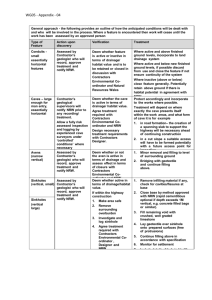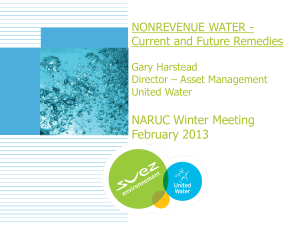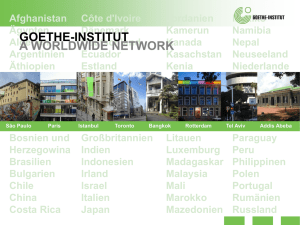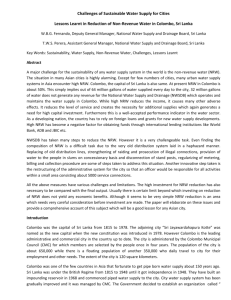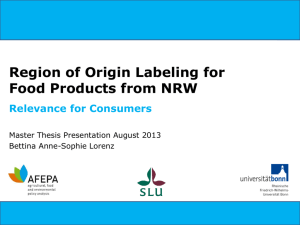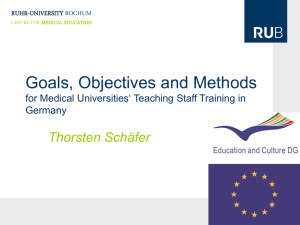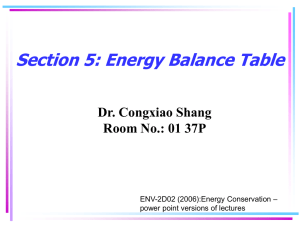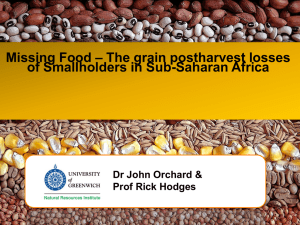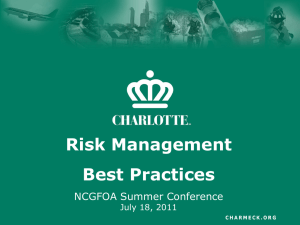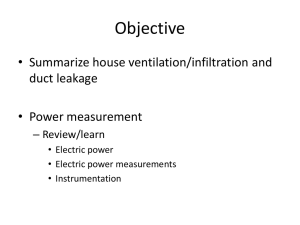9_-_Mutikanga_Non-Revenue_Water_Entebbe
advertisement
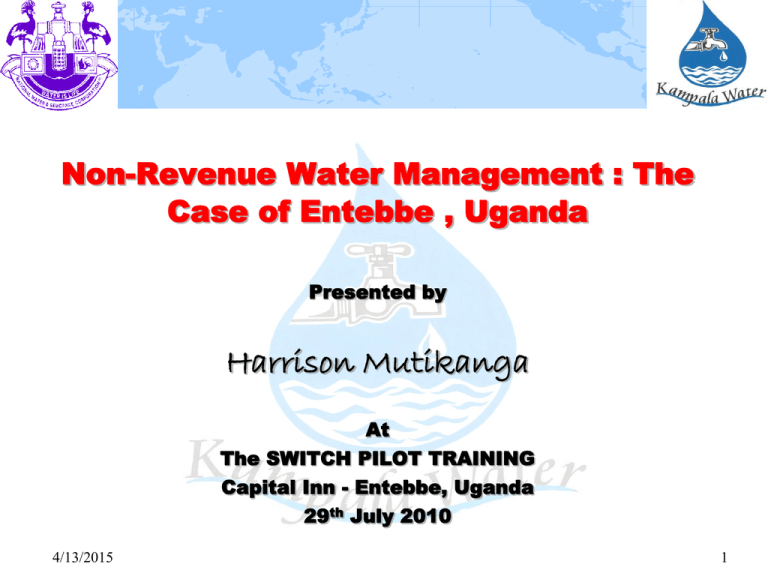
Non-Revenue Water Management : The Case of Entebbe , Uganda Presented by Harrison Mutikanga At The SWITCH PILOT TRAINING Capital Inn - Entebbe, Uganda 29th July 2010 4/13/2015 1 Presentation Outline i. Definitions, Terminologies & Problem Identification ii. IWA Water Balance Methodology iii. NRW Contributing Factors iv. Tools for Managing Water Losses v. Entebbe NRW Case Study vi. Conclusions 4/13/2015 2 Basic Definitions NON-REVENUE WATER WATER SUPPLIED = (NRW) NRW REAL = = LOSSES APPARENT LOSSES (Commercial Losses) REVENUE WATER - (Billed Consumed Water) (System input Volume) Water Losses (Real + Apparent) + Unbilled Authorised Consumption •Physical losses from pipes , joints & fittings (Leakage & Bursts) •Service reservoirs overflows = Meter readings, illegal connections, illegal use Basic Definitions Water Losses occur as two distinct types: Real Losses (Leakage) – physical losses Apparent (Commercial) Losses: water used by customers but not properly measured and paid for 4/13/2015 4 What is the Problem? Technical: Not all water Supplied by a utility reaches the customer Financial & Economic: not all the water supplied is paid for Terminology: Lack of standardized definitions of water and revenue water losses 4/13/2015 5 NRW in African Cities Source: (WSP-World Bank, 2009) 4/13/2015 6 NRW in Asian Cities (2001) Less than 20% of population served in Delhi gets 24-hr water service BestPractice Frontier Source: (McIntosh, 2003) 4/13/2015 7 IWA WB Methodology 4/13/2015 8 Importance of Water Balance Provides answers to the following questions: Why is water lost ? Where is it lost ? How is it lost ? Formulating reduction strategies and prioritizing investments Tool for communication & benchmarking 4/13/2015 9 Contributing Factors to NRW Old infrastructure High Pressures Road Works Abuse of Fire hydrants 4/13/2015 10 Contributing Factors to NRW Meter inaccuracies, Meter-bypass, Theft / illegal connections 4/13/2015 11 Tools for Managing Real Losses 4/13/2015 12 Tools for Managing Apparent Losses 4/13/2015 13 Service Reservoir WOA WTW Distribution Input WSZ DMA Meter Service Reservoir DMAs as Leakage ManagementTools Pressure Management as a Tool Source: McKenzie, 2009 4/13/2015 15 Network Hydraulic Modeling as a Tool Leakage analysis Design pressure management schemes Network Planning DMA Optimization Mains Replacement Introduce PRV to reduce high pressure and leakage Increase pressure to reduce low pressure complaints 4/13/2015 16 Assessing ELL Losses from reported bursts ALC cost Base/ Background Losses Total cost Annual Cost £/Yr Losses from unreported bursts 0 Levels of loses Ml/d Cost of Water Entebbe NRW Case Study Introduction The performance of Entebbe network Initiatives undertaken to improve NRW Benefits Challenges & lessons 4/13/2015 18 Introduction Entebbe is located 34km south of Kampala It is the 3rd largest town out of the 22 towns operated by NWSC, Started operations in 1950 Estimated area population 215,000 Service coverage is about 70% 4/13/2015 19 Performance History 4/13/2015 20 Network Performance 4/13/2015 21 System Characteristics 4/13/2015 22 Water Balance – 2003 4/13/2015 3 (m /year) 23 Water Balance – 2007 4/13/2015 3 (m /year) 24 NRW Performance Indicators 4/13/2015 25 Commercial & Physical Loss PIs 4/13/2015 26 Leakage Component Analysis 4/13/2015 27 Reasons for NRW Improvement 4/13/2015 28 Reasons for NRW Improvement Developed a compressive 5 yr action plan - using a participatory approach & with clear time bound objectives & strategies – (reduce NRW from 32% to 15 % by 2008) Established a GIS system & carried out comprehensive documentation & mapping the whole network area Shared experience & information with sister utilities on the challenges & initiatives of NRW reduction – e.g WUP & WEDC forum 4/13/2015 29 Reasons for NRW Improvement Undertook pilot studies of the distribution network & technically isolate 3 discrete zones Set up of three DMAs – with demarcated customer accounts, Aligned the organization structure to the Zones and allocated staff & other resources for accountability enhancement (Territorial Management Concept) Appointed Zonal leaders accountable for the Zones performance Aligned the billing system with the Zones for easy monitoring Set targets for each Zone & established an incentive mechanism to drive performance Carried out regular performance monitoring of the Zones 4/13/2015 30 Reasons for NRW Improvement Entebbe Area – District Meter Areas (DMAs) 4/13/2015 31 Reasons for NRW Improvement Organization Structure focused on NRW reductions Area Manager Internal Auditor Management & Support Services 4/13/2015 Finance & Accounts Services Technical Services Zonal 1 Zonal 2 (Zonal leader, M/Reader, Plumbers, Mates) (Zonal leader, M/Reader, Plumbers, Mates) Commercial & Customer Care Services Zonal 3 (Zonal leader, M/Reader, Plumbers, Mates) Water Production & Sewerage 32 Initiatives to address Leakage Established a standby 24 hrs leak management unit – speed and quality of repairs –leakage handling efficiency (identified leaks repaired in < 6hrs) Trained staff on effective leak detection, repair & monitoring (in house & external training) & equipped them with newly acquired leak detection equipments Established a more pro-active leak detection & repair programme Sensitized & encouraged the public to vigorously report water leaks/bursts – attached a reward ($1.5 -3) for @ case reported Computerised the leaks reporting register for easy tracking & monitoring 4/13/2015 33 Initiatives to address Leakage Routine inspection & servicing of valves & fire hydrants Leak clustering for better monitoring of network condition thus planning for replacement. Developed a medium term investment plan – replacement of old pipelines of the water distribution network 12.4 Km of worn out pipes were replaced more than 60% of the network is currently less than 5 Years old 4/13/2015 34 Initiatives to address CL Carried out investigations to detect & cut–off illegal connections from the mains Declared Monday an illegal connection day – investigating cases of suspected illegal connections Worked closely with local communities to identify illegal cases & meter vandalism Offered incentives/rewards to informers of illegal users – ($32 for commercial, UGX $20 for domestic & $3 to staff) Established fines/ penalties for illegal connections – $305 + 2 yrs estimated consumption Established amnesty programmes to woo back illegal consumers 4/13/2015 35 Initiatives to address CL Regular spot checks on large customers & construction sites Spot checks and auditing of meter readings + rotation of meter readers (every 6 months) Meter testing in the laboratory and replacing meters that under-register consumption Universal metering of customer accounts - (all accounts metered & over 70% of the meters are less 6 yrs old) 4/13/2015 36 Initiatives to address CL Prompt updating of customer database –NCs updated within 2 days Effective disconnection for non-payment - some customers disconnected from the main Right sizing of meters based on customer demand profiles for effective recording of consumption esp. bulk meters Introduced New Connection Policy – NWSC procures & install all water pipes & fitting and also maintains the service line – standardization of pipes & fittings - quality 4/13/2015 37 Costs and Benefits Reduced NRW from 32% to 17% – reducing operating costs & saved more water for sales Reduced leak repair costs – improved network performance Strengthened staff capacity in water loss reduction Enhanced public awareness & improved corporate image 4/13/2015 38 Challenges Sustaining and improving performance further (Economic levels of leakage –ELL and Economic levels of apparent losses – ELAL). Improving the accuracy of the individual components of the water balance for clear prioritisation of actions and investments Re-zoning the network into hydraulic zones & DMAs Accurate data for GIS and constructing network hydraulic models Elimination of Illegal connections – dynamic problem Appropriate NRW indicators to promote utility benchmarking 4/13/2015 39 Lessons Learned Reducing NRW is an on-going activity and not a one-off exercise NRW is expensive and needs investment to be reduced - is self financing in the long run. Combating commercial losses requires less investments but high mgt commitment, community support & appropriate incentives Pilot area projects are recommended for testing new techniques and quantifying costs and benefits of NRW reduction Staff involvement & ownership is critical for successful reduction of NRW Utility performance benchmarking is a powerful tool for reducing NRW. 4/13/2015 40 Sustainable Water Services Investment Strategy Treatment Works Network Assets Year 3 Service Levels Shareholders Revenue Collection Conclusions NRW is a problem for most Utilities worldwide The water balance & PIs are effective tools for assessment of NRW and for performance benchmarking The Entebbe case study demonstrates that significant water savings can be made even in developing countries with appropriate technical support and training Address poor governance & institutional challenges The Shared experience during this training should be a catalyst for action to save and conserve water 4/13/2015 42 Thank you for your Attention Our Shared Objective: “Sustainable water services thru NRW reduction” 4/13/2015 43
